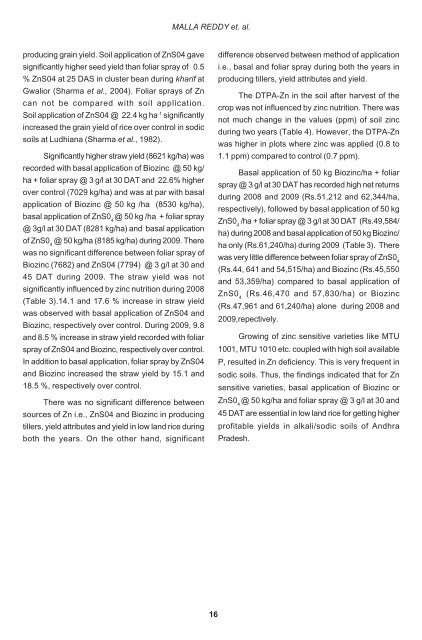physicochemical
Contents of 39(1 & 2) 2011 - acharya ng ranga agricultural university
Contents of 39(1 & 2) 2011 - acharya ng ranga agricultural university
- No tags were found...
Create successful ePaper yourself
Turn your PDF publications into a flip-book with our unique Google optimized e-Paper software.
MALLA REDDY et. al.<br />
producing grain yield. Soil application of ZnS04 gave<br />
significantly higher seed yield than foliar spray of 0.5<br />
% ZnS04 at 25 DAS in cluster bean during kharif at<br />
Gwalior (Sharma et al., 2004). Foliar sprays of Zn<br />
can not be compared with soil application.<br />
Soil application of ZnS04 @ 22.4 kg ha -1 significantly<br />
increased the grain yield of rice over control in sodic<br />
soils at Ludhiana (Sharma et al., 1982).<br />
Significantly higher straw yield (8621 kg/ha) was<br />
recorded with basal application of Biozinc @ 50 kg/<br />
ha + foliar spray @ 3 g/l at 30 DAT and 22.6% higher<br />
over control (7029 kg/ha) and was at par with basal<br />
application of Biozinc @ 50 kg /ha (8530 kg/ha),<br />
basal application of ZnS0 4<br />
@ 50 kg /ha + foliar spray<br />
@ 3g/l at 30 DAT (8281 kg/ha) and basal application<br />
of ZnS0 4<br />
@ 50 kg/ha (8185 kg/ha) during 2009. There<br />
was no significant difference between foliar spray of<br />
Biozinc (7682) and ZnS04 (7794) @ 3 g/l at 30 and<br />
45 DAT during 2009. The straw yield was not<br />
significantly influenced by zinc nutrition during 2008<br />
(Table 3).14.1 and 17.6 % increase in straw yield<br />
was observed with basal application of ZnS04 and<br />
Biozinc, respectively over control. During 2009, 9.8<br />
and 8.5 % increase in straw yield recorded with foliar<br />
spray of ZnS04 and Biozinc, respectively over control.<br />
In addition to basal application, foliar spray by ZnS04<br />
and Biozinc increased the straw yield by 15.1 and<br />
18.5 %, respectively over control.<br />
There was no significant difference between<br />
sources of Zn i.e., ZnS04 and Biozinc in producing<br />
tillers, yield attributes and yield in low land rice during<br />
both the years. On the other hand, significant<br />
difference observed between method of application<br />
i.e., basal and foliar spray during both the years in<br />
producing tillers, yield attributes and yield.<br />
The DTPA-Zn in the soil after harvest of the<br />
crop was not influenced by zinc nutrition. There was<br />
not much change in the values (ppm) of soil zinc<br />
during two years (Table 4). However, the DTPA-Zn<br />
was higher in plots where zinc was applied (0.8 to<br />
1.1 ppm) compared to control (0.7 ppm).<br />
Basal application of 50 kg Biozinc/ha + foliar<br />
spray @ 3 g/l at 30 DAT has recorded high net returns<br />
during 2008 and 2009 (Rs.51,212 and 62,344/ha,<br />
respectively), followed by basal application of 50 kg<br />
ZnS0 4<br />
/ha + foliar spray @ 3 g/l at 30 DAT (Rs.49,584/<br />
ha) during 2008 and basal application of 50 kg Biozinc/<br />
ha only (Rs.61,240/ha) during 2009 (Table 3). There<br />
was very little difference between foliar spray of ZnS0 4<br />
(Rs.44, 641 and 54,515/ha) and Biozinc (Rs.45,550<br />
and 53,359/ha) compared to basal application of<br />
ZnS0 4<br />
(Rs.46,470 and 57,830/ha) or Biozinc<br />
(Rs.47,961 and 61,240/ha) alone during 2008 and<br />
2009,repectively.<br />
Growing of zinc sensitive varieties like MTU<br />
1001, MTU 1010 etc. coupled with high soil available<br />
P, resulted in Zn deficiency. This is very frequent in<br />
sodic soils. Thus, the findings indicated that for Zn<br />
sensitive varieties, basal application of Biozinc or<br />
ZnS0 4<br />
@ 50 kg/ha and foliar spray @ 3 g/l at 30 and<br />
45 DAT are essential in low land rice for getting higher<br />
profitable yields in alkali/sodic soils of Andhra<br />
Pradesh.<br />
16
















